Management Report: AFF Vision, Mission, and Organizational Culture
VerifiedAdded on 2020/02/24
|16
|3278
|40
Report
AI Summary
This report provides an in-depth analysis of the Australian Football Federation (AFF). It begins with an executive summary and introduction, outlining the organization's vision, mission, and operational structure. The discussion section delves into the specific environment of the AFF, identifying key stakeholders, strategic partners, and external factors influencing its performance. The report then explores the corporate social responsibility (CSR) initiatives of the AFF, examining its ethical code of conduct and commitment to stakeholders. Furthermore, the report assesses the internal organizational culture of the AFF, including the types of culture that fit the organization. The report concludes with a summary of the key findings and references relevant literature.
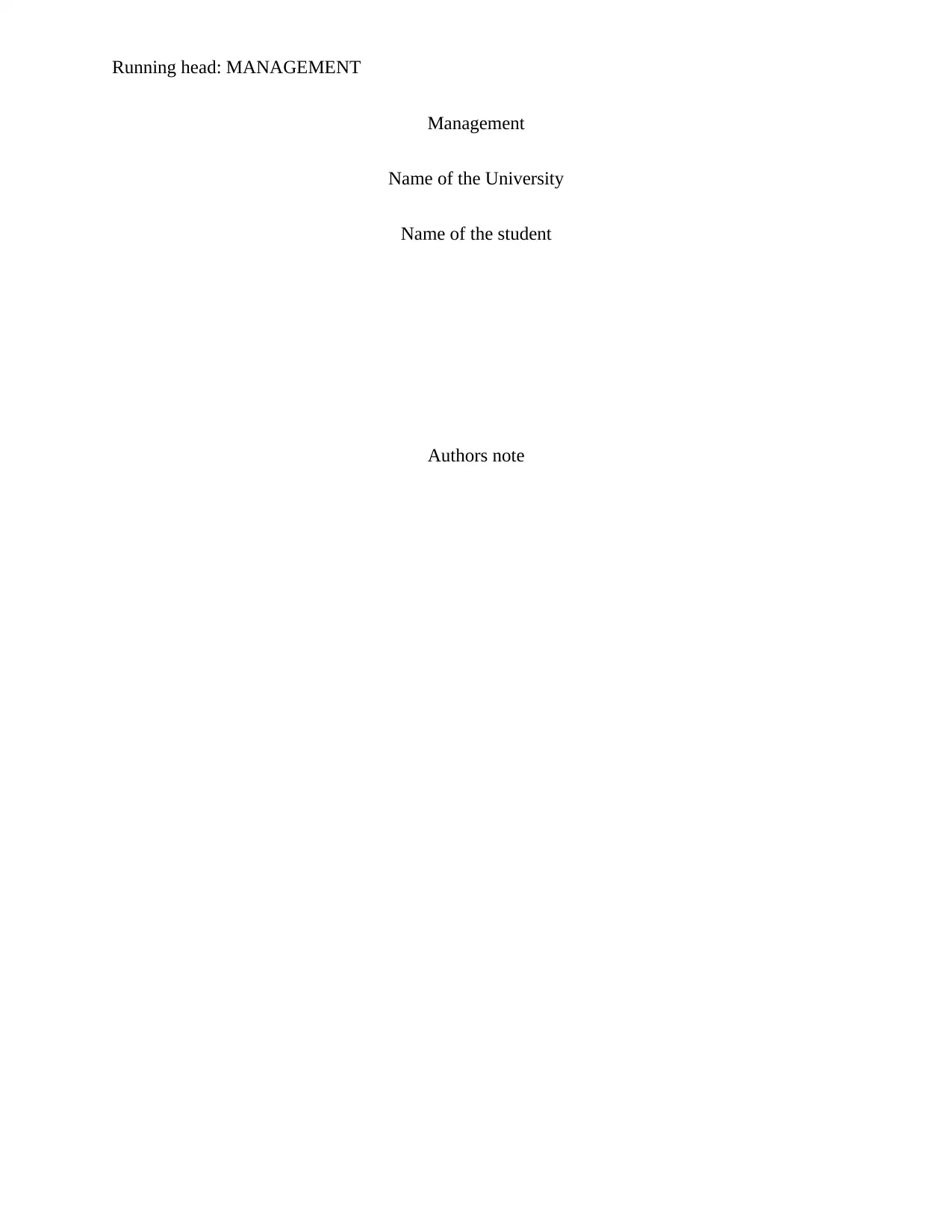
Running head: MANAGEMENT
Management
Name of the University
Name of the student
Authors note
Management
Name of the University
Name of the student
Authors note
Paraphrase This Document
Need a fresh take? Get an instant paraphrase of this document with our AI Paraphraser
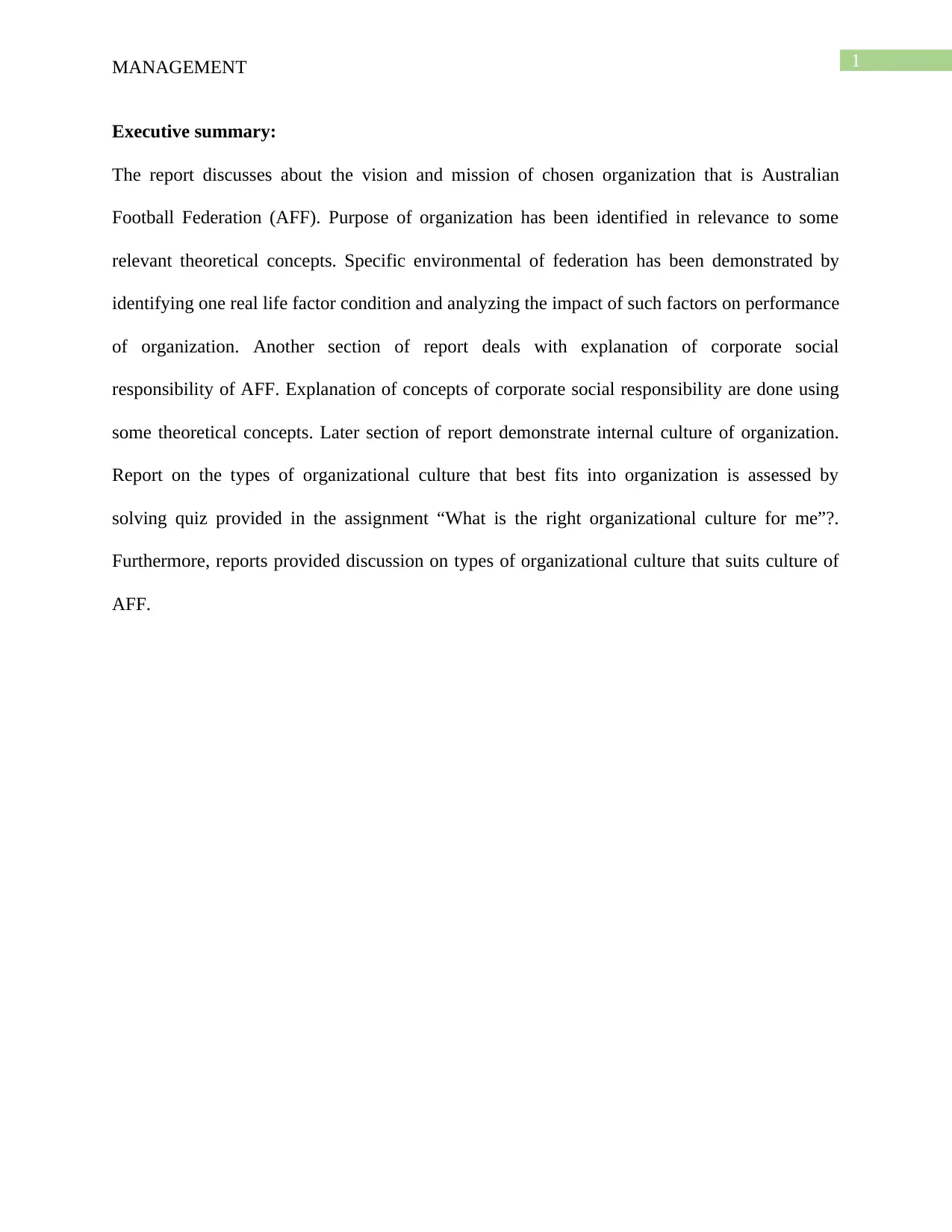
1MANAGEMENT
Executive summary:
The report discusses about the vision and mission of chosen organization that is Australian
Football Federation (AFF). Purpose of organization has been identified in relevance to some
relevant theoretical concepts. Specific environmental of federation has been demonstrated by
identifying one real life factor condition and analyzing the impact of such factors on performance
of organization. Another section of report deals with explanation of corporate social
responsibility of AFF. Explanation of concepts of corporate social responsibility are done using
some theoretical concepts. Later section of report demonstrate internal culture of organization.
Report on the types of organizational culture that best fits into organization is assessed by
solving quiz provided in the assignment “What is the right organizational culture for me”?.
Furthermore, reports provided discussion on types of organizational culture that suits culture of
AFF.
Executive summary:
The report discusses about the vision and mission of chosen organization that is Australian
Football Federation (AFF). Purpose of organization has been identified in relevance to some
relevant theoretical concepts. Specific environmental of federation has been demonstrated by
identifying one real life factor condition and analyzing the impact of such factors on performance
of organization. Another section of report deals with explanation of corporate social
responsibility of AFF. Explanation of concepts of corporate social responsibility are done using
some theoretical concepts. Later section of report demonstrate internal culture of organization.
Report on the types of organizational culture that best fits into organization is assessed by
solving quiz provided in the assignment “What is the right organizational culture for me”?.
Furthermore, reports provided discussion on types of organizational culture that suits culture of
AFF.
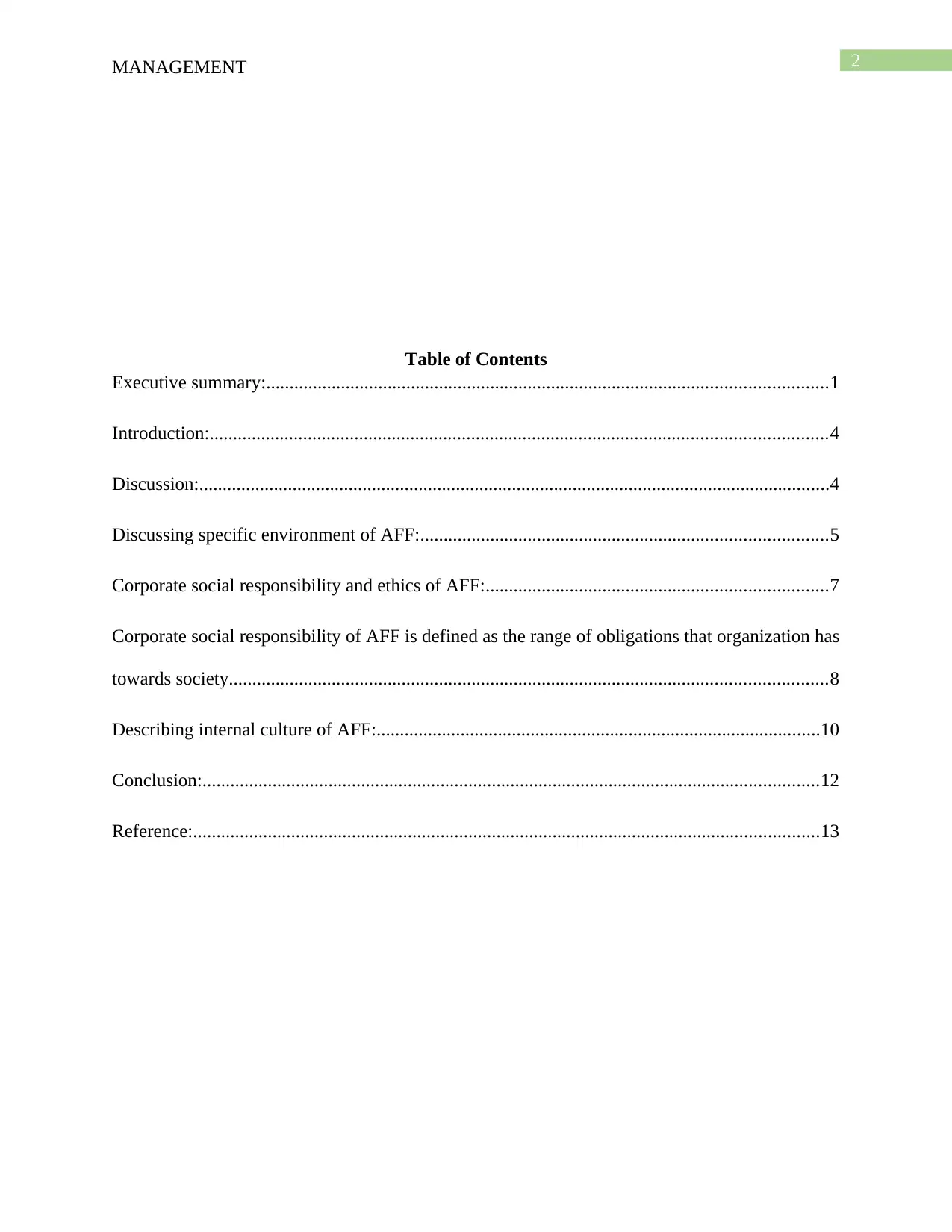
2MANAGEMENT
Table of Contents
Executive summary:........................................................................................................................1
Introduction:....................................................................................................................................4
Discussion:.......................................................................................................................................4
Discussing specific environment of AFF:.......................................................................................5
Corporate social responsibility and ethics of AFF:.........................................................................7
Corporate social responsibility of AFF is defined as the range of obligations that organization has
towards society................................................................................................................................8
Describing internal culture of AFF:...............................................................................................10
Conclusion:....................................................................................................................................12
Reference:......................................................................................................................................13
Table of Contents
Executive summary:........................................................................................................................1
Introduction:....................................................................................................................................4
Discussion:.......................................................................................................................................4
Discussing specific environment of AFF:.......................................................................................5
Corporate social responsibility and ethics of AFF:.........................................................................7
Corporate social responsibility of AFF is defined as the range of obligations that organization has
towards society................................................................................................................................8
Describing internal culture of AFF:...............................................................................................10
Conclusion:....................................................................................................................................12
Reference:......................................................................................................................................13
⊘ This is a preview!⊘
Do you want full access?
Subscribe today to unlock all pages.

Trusted by 1+ million students worldwide
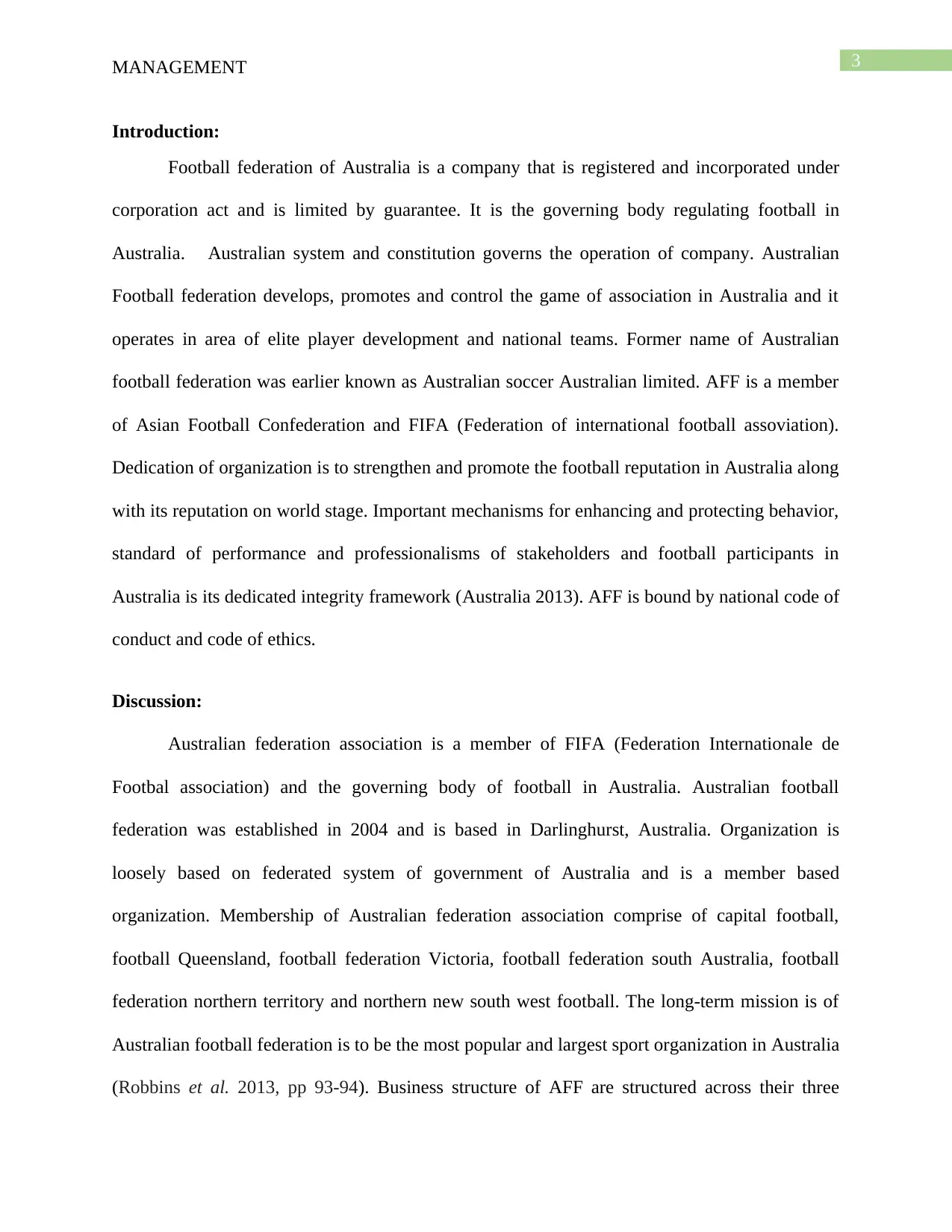
3MANAGEMENT
Introduction:
Football federation of Australia is a company that is registered and incorporated under
corporation act and is limited by guarantee. It is the governing body regulating football in
Australia. Australian system and constitution governs the operation of company. Australian
Football federation develops, promotes and control the game of association in Australia and it
operates in area of elite player development and national teams. Former name of Australian
football federation was earlier known as Australian soccer Australian limited. AFF is a member
of Asian Football Confederation and FIFA (Federation of international football assoviation).
Dedication of organization is to strengthen and promote the football reputation in Australia along
with its reputation on world stage. Important mechanisms for enhancing and protecting behavior,
standard of performance and professionalisms of stakeholders and football participants in
Australia is its dedicated integrity framework (Australia 2013). AFF is bound by national code of
conduct and code of ethics.
Discussion:
Australian federation association is a member of FIFA (Federation Internationale de
Footbal association) and the governing body of football in Australia. Australian football
federation was established in 2004 and is based in Darlinghurst, Australia. Organization is
loosely based on federated system of government of Australia and is a member based
organization. Membership of Australian federation association comprise of capital football,
football Queensland, football federation Victoria, football federation south Australia, football
federation northern territory and northern new south west football. The long-term mission is of
Australian football federation is to be the most popular and largest sport organization in Australia
(Robbins et al. 2013, pp 93-94). Business structure of AFF are structured across their three
Introduction:
Football federation of Australia is a company that is registered and incorporated under
corporation act and is limited by guarantee. It is the governing body regulating football in
Australia. Australian system and constitution governs the operation of company. Australian
Football federation develops, promotes and control the game of association in Australia and it
operates in area of elite player development and national teams. Former name of Australian
football federation was earlier known as Australian soccer Australian limited. AFF is a member
of Asian Football Confederation and FIFA (Federation of international football assoviation).
Dedication of organization is to strengthen and promote the football reputation in Australia along
with its reputation on world stage. Important mechanisms for enhancing and protecting behavior,
standard of performance and professionalisms of stakeholders and football participants in
Australia is its dedicated integrity framework (Australia 2013). AFF is bound by national code of
conduct and code of ethics.
Discussion:
Australian federation association is a member of FIFA (Federation Internationale de
Footbal association) and the governing body of football in Australia. Australian football
federation was established in 2004 and is based in Darlinghurst, Australia. Organization is
loosely based on federated system of government of Australia and is a member based
organization. Membership of Australian federation association comprise of capital football,
football Queensland, football federation Victoria, football federation south Australia, football
federation northern territory and northern new south west football. The long-term mission is of
Australian football federation is to be the most popular and largest sport organization in Australia
(Robbins et al. 2013, pp 93-94). Business structure of AFF are structured across their three
Paraphrase This Document
Need a fresh take? Get an instant paraphrase of this document with our AI Paraphraser
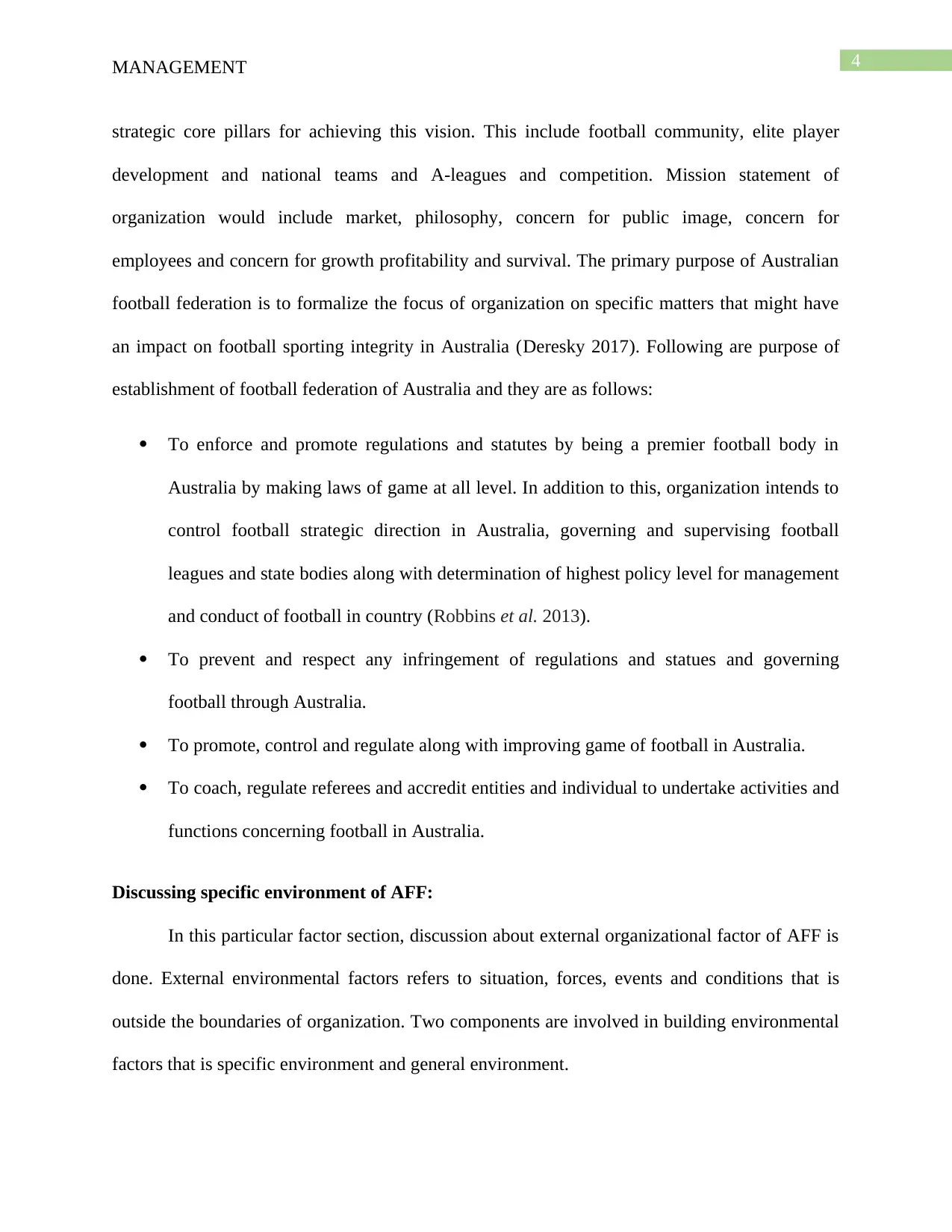
4MANAGEMENT
strategic core pillars for achieving this vision. This include football community, elite player
development and national teams and A-leagues and competition. Mission statement of
organization would include market, philosophy, concern for public image, concern for
employees and concern for growth profitability and survival. The primary purpose of Australian
football federation is to formalize the focus of organization on specific matters that might have
an impact on football sporting integrity in Australia (Deresky 2017). Following are purpose of
establishment of football federation of Australia and they are as follows:
To enforce and promote regulations and statutes by being a premier football body in
Australia by making laws of game at all level. In addition to this, organization intends to
control football strategic direction in Australia, governing and supervising football
leagues and state bodies along with determination of highest policy level for management
and conduct of football in country (Robbins et al. 2013).
To prevent and respect any infringement of regulations and statues and governing
football through Australia.
To promote, control and regulate along with improving game of football in Australia.
To coach, regulate referees and accredit entities and individual to undertake activities and
functions concerning football in Australia.
Discussing specific environment of AFF:
In this particular factor section, discussion about external organizational factor of AFF is
done. External environmental factors refers to situation, forces, events and conditions that is
outside the boundaries of organization. Two components are involved in building environmental
factors that is specific environment and general environment.
strategic core pillars for achieving this vision. This include football community, elite player
development and national teams and A-leagues and competition. Mission statement of
organization would include market, philosophy, concern for public image, concern for
employees and concern for growth profitability and survival. The primary purpose of Australian
football federation is to formalize the focus of organization on specific matters that might have
an impact on football sporting integrity in Australia (Deresky 2017). Following are purpose of
establishment of football federation of Australia and they are as follows:
To enforce and promote regulations and statutes by being a premier football body in
Australia by making laws of game at all level. In addition to this, organization intends to
control football strategic direction in Australia, governing and supervising football
leagues and state bodies along with determination of highest policy level for management
and conduct of football in country (Robbins et al. 2013).
To prevent and respect any infringement of regulations and statues and governing
football through Australia.
To promote, control and regulate along with improving game of football in Australia.
To coach, regulate referees and accredit entities and individual to undertake activities and
functions concerning football in Australia.
Discussing specific environment of AFF:
In this particular factor section, discussion about external organizational factor of AFF is
done. External environmental factors refers to situation, forces, events and conditions that is
outside the boundaries of organization. Two components are involved in building environmental
factors that is specific environment and general environment.
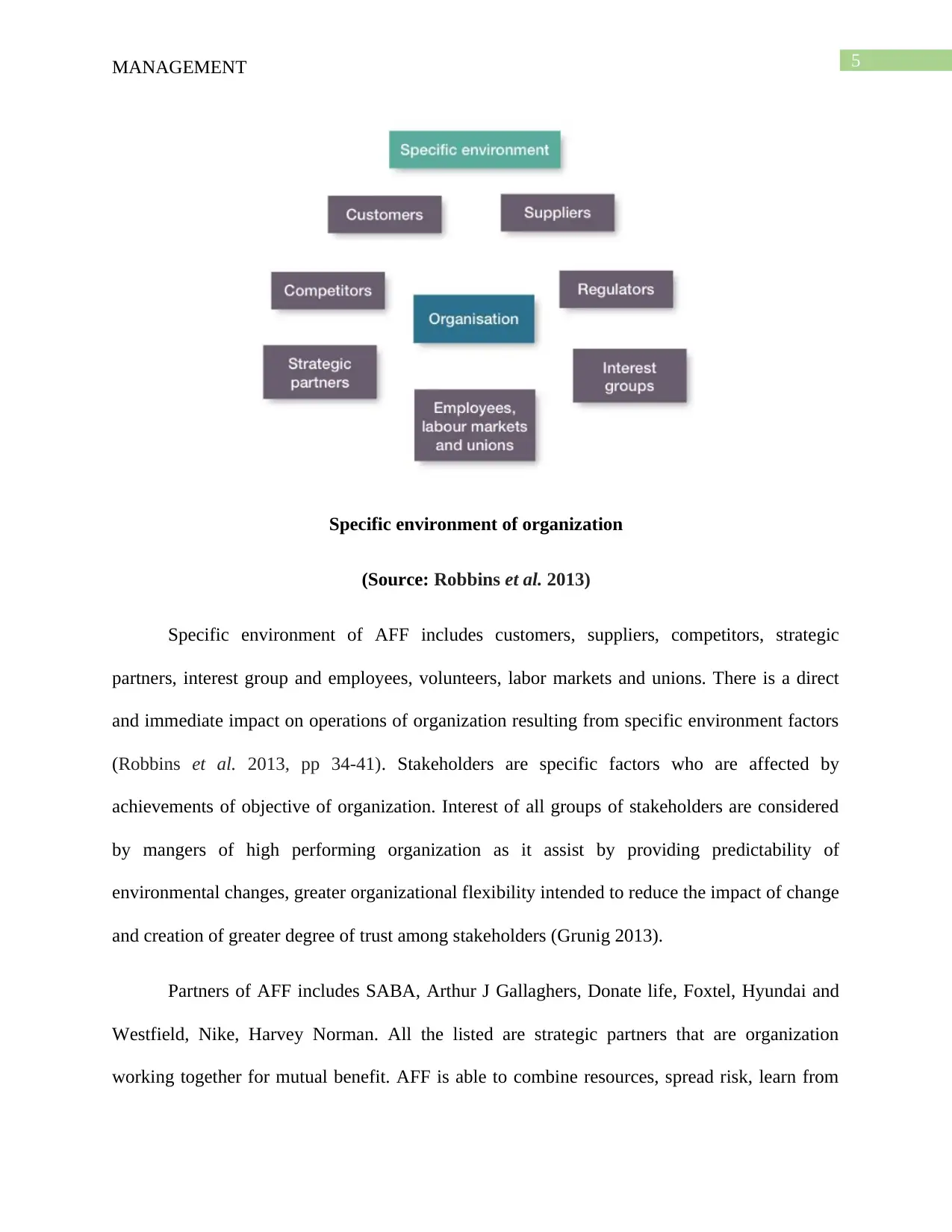
5MANAGEMENT
Specific environment of organization
(Source: Robbins et al. 2013)
Specific environment of AFF includes customers, suppliers, competitors, strategic
partners, interest group and employees, volunteers, labor markets and unions. There is a direct
and immediate impact on operations of organization resulting from specific environment factors
(Robbins et al. 2013, pp 34-41). Stakeholders are specific factors who are affected by
achievements of objective of organization. Interest of all groups of stakeholders are considered
by mangers of high performing organization as it assist by providing predictability of
environmental changes, greater organizational flexibility intended to reduce the impact of change
and creation of greater degree of trust among stakeholders (Grunig 2013).
Partners of AFF includes SABA, Arthur J Gallaghers, Donate life, Foxtel, Hyundai and
Westfield, Nike, Harvey Norman. All the listed are strategic partners that are organization
working together for mutual benefit. AFF is able to combine resources, spread risk, learn from
Specific environment of organization
(Source: Robbins et al. 2013)
Specific environment of AFF includes customers, suppliers, competitors, strategic
partners, interest group and employees, volunteers, labor markets and unions. There is a direct
and immediate impact on operations of organization resulting from specific environment factors
(Robbins et al. 2013, pp 34-41). Stakeholders are specific factors who are affected by
achievements of objective of organization. Interest of all groups of stakeholders are considered
by mangers of high performing organization as it assist by providing predictability of
environmental changes, greater organizational flexibility intended to reduce the impact of change
and creation of greater degree of trust among stakeholders (Grunig 2013).
Partners of AFF includes SABA, Arthur J Gallaghers, Donate life, Foxtel, Hyundai and
Westfield, Nike, Harvey Norman. All the listed are strategic partners that are organization
working together for mutual benefit. AFF is able to combine resources, spread risk, learn from
⊘ This is a preview!⊘
Do you want full access?
Subscribe today to unlock all pages.

Trusted by 1+ million students worldwide
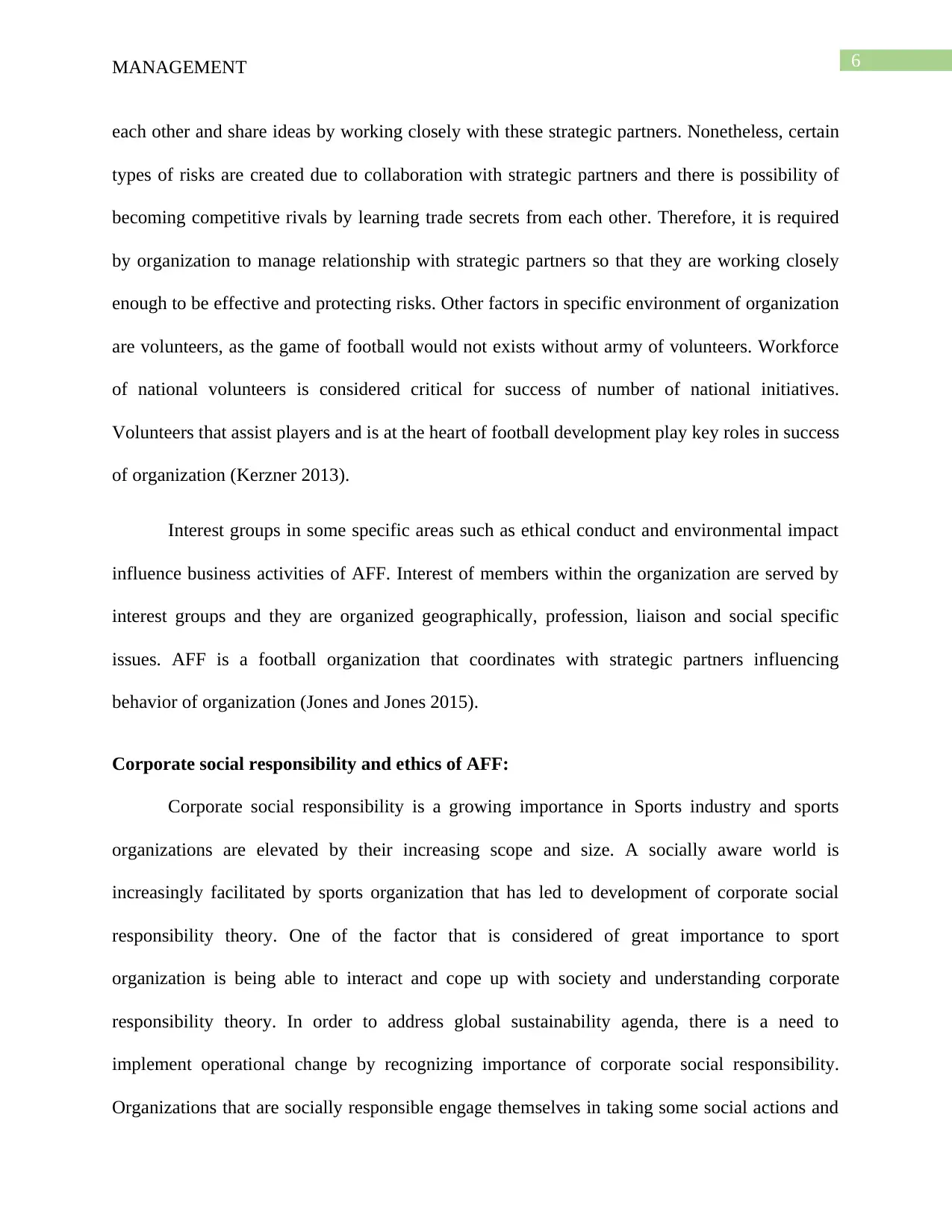
6MANAGEMENT
each other and share ideas by working closely with these strategic partners. Nonetheless, certain
types of risks are created due to collaboration with strategic partners and there is possibility of
becoming competitive rivals by learning trade secrets from each other. Therefore, it is required
by organization to manage relationship with strategic partners so that they are working closely
enough to be effective and protecting risks. Other factors in specific environment of organization
are volunteers, as the game of football would not exists without army of volunteers. Workforce
of national volunteers is considered critical for success of number of national initiatives.
Volunteers that assist players and is at the heart of football development play key roles in success
of organization (Kerzner 2013).
Interest groups in some specific areas such as ethical conduct and environmental impact
influence business activities of AFF. Interest of members within the organization are served by
interest groups and they are organized geographically, profession, liaison and social specific
issues. AFF is a football organization that coordinates with strategic partners influencing
behavior of organization (Jones and Jones 2015).
Corporate social responsibility and ethics of AFF:
Corporate social responsibility is a growing importance in Sports industry and sports
organizations are elevated by their increasing scope and size. A socially aware world is
increasingly facilitated by sports organization that has led to development of corporate social
responsibility theory. One of the factor that is considered of great importance to sport
organization is being able to interact and cope up with society and understanding corporate
responsibility theory. In order to address global sustainability agenda, there is a need to
implement operational change by recognizing importance of corporate social responsibility.
Organizations that are socially responsible engage themselves in taking some social actions and
each other and share ideas by working closely with these strategic partners. Nonetheless, certain
types of risks are created due to collaboration with strategic partners and there is possibility of
becoming competitive rivals by learning trade secrets from each other. Therefore, it is required
by organization to manage relationship with strategic partners so that they are working closely
enough to be effective and protecting risks. Other factors in specific environment of organization
are volunteers, as the game of football would not exists without army of volunteers. Workforce
of national volunteers is considered critical for success of number of national initiatives.
Volunteers that assist players and is at the heart of football development play key roles in success
of organization (Kerzner 2013).
Interest groups in some specific areas such as ethical conduct and environmental impact
influence business activities of AFF. Interest of members within the organization are served by
interest groups and they are organized geographically, profession, liaison and social specific
issues. AFF is a football organization that coordinates with strategic partners influencing
behavior of organization (Jones and Jones 2015).
Corporate social responsibility and ethics of AFF:
Corporate social responsibility is a growing importance in Sports industry and sports
organizations are elevated by their increasing scope and size. A socially aware world is
increasingly facilitated by sports organization that has led to development of corporate social
responsibility theory. One of the factor that is considered of great importance to sport
organization is being able to interact and cope up with society and understanding corporate
responsibility theory. In order to address global sustainability agenda, there is a need to
implement operational change by recognizing importance of corporate social responsibility.
Organizations that are socially responsible engage themselves in taking some social actions and
Paraphrase This Document
Need a fresh take? Get an instant paraphrase of this document with our AI Paraphraser
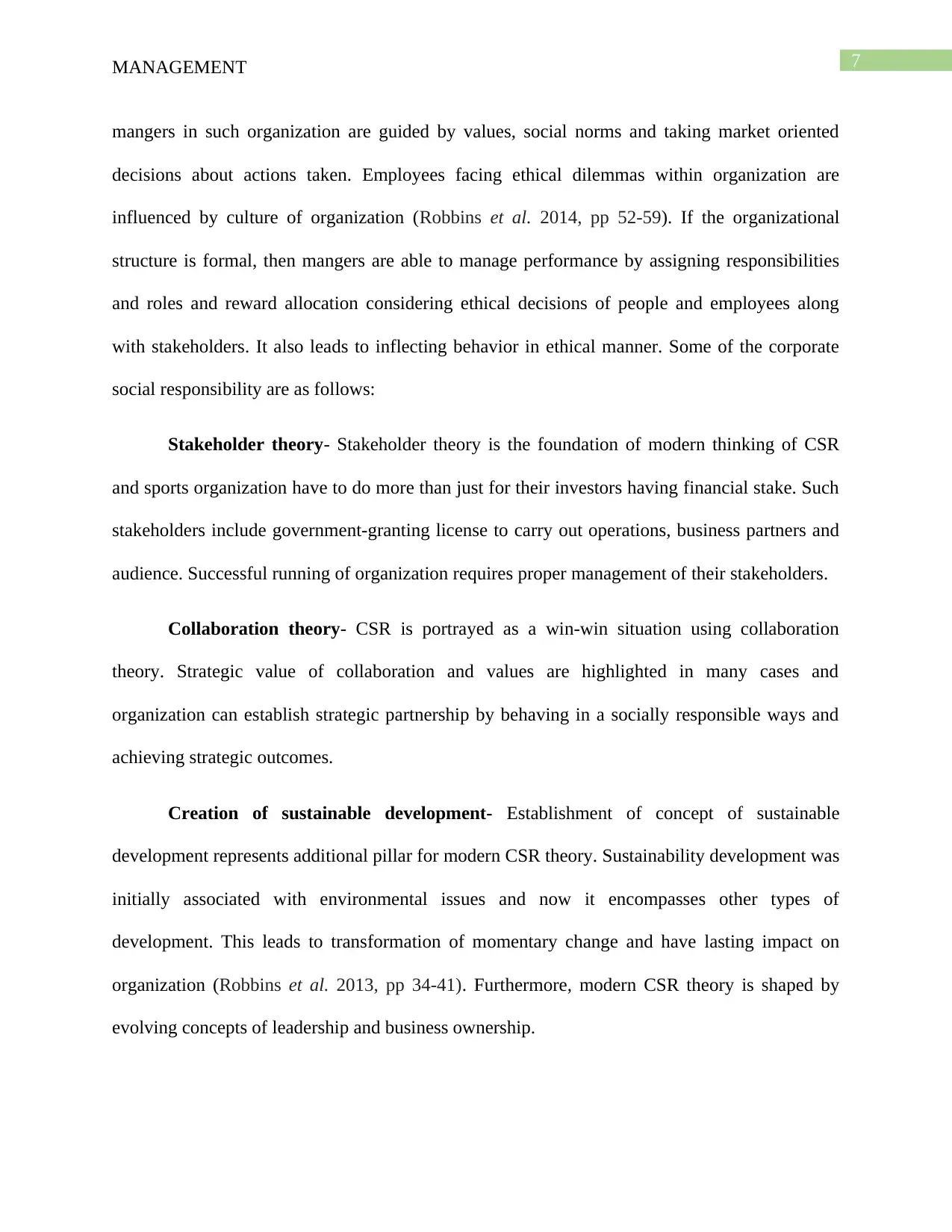
7MANAGEMENT
mangers in such organization are guided by values, social norms and taking market oriented
decisions about actions taken. Employees facing ethical dilemmas within organization are
influenced by culture of organization (Robbins et al. 2014, pp 52-59). If the organizational
structure is formal, then mangers are able to manage performance by assigning responsibilities
and roles and reward allocation considering ethical decisions of people and employees along
with stakeholders. It also leads to inflecting behavior in ethical manner. Some of the corporate
social responsibility are as follows:
Stakeholder theory- Stakeholder theory is the foundation of modern thinking of CSR
and sports organization have to do more than just for their investors having financial stake. Such
stakeholders include government-granting license to carry out operations, business partners and
audience. Successful running of organization requires proper management of their stakeholders.
Collaboration theory- CSR is portrayed as a win-win situation using collaboration
theory. Strategic value of collaboration and values are highlighted in many cases and
organization can establish strategic partnership by behaving in a socially responsible ways and
achieving strategic outcomes.
Creation of sustainable development- Establishment of concept of sustainable
development represents additional pillar for modern CSR theory. Sustainability development was
initially associated with environmental issues and now it encompasses other types of
development. This leads to transformation of momentary change and have lasting impact on
organization (Robbins et al. 2013, pp 34-41). Furthermore, modern CSR theory is shaped by
evolving concepts of leadership and business ownership.
mangers in such organization are guided by values, social norms and taking market oriented
decisions about actions taken. Employees facing ethical dilemmas within organization are
influenced by culture of organization (Robbins et al. 2014, pp 52-59). If the organizational
structure is formal, then mangers are able to manage performance by assigning responsibilities
and roles and reward allocation considering ethical decisions of people and employees along
with stakeholders. It also leads to inflecting behavior in ethical manner. Some of the corporate
social responsibility are as follows:
Stakeholder theory- Stakeholder theory is the foundation of modern thinking of CSR
and sports organization have to do more than just for their investors having financial stake. Such
stakeholders include government-granting license to carry out operations, business partners and
audience. Successful running of organization requires proper management of their stakeholders.
Collaboration theory- CSR is portrayed as a win-win situation using collaboration
theory. Strategic value of collaboration and values are highlighted in many cases and
organization can establish strategic partnership by behaving in a socially responsible ways and
achieving strategic outcomes.
Creation of sustainable development- Establishment of concept of sustainable
development represents additional pillar for modern CSR theory. Sustainability development was
initially associated with environmental issues and now it encompasses other types of
development. This leads to transformation of momentary change and have lasting impact on
organization (Robbins et al. 2013, pp 34-41). Furthermore, modern CSR theory is shaped by
evolving concepts of leadership and business ownership.
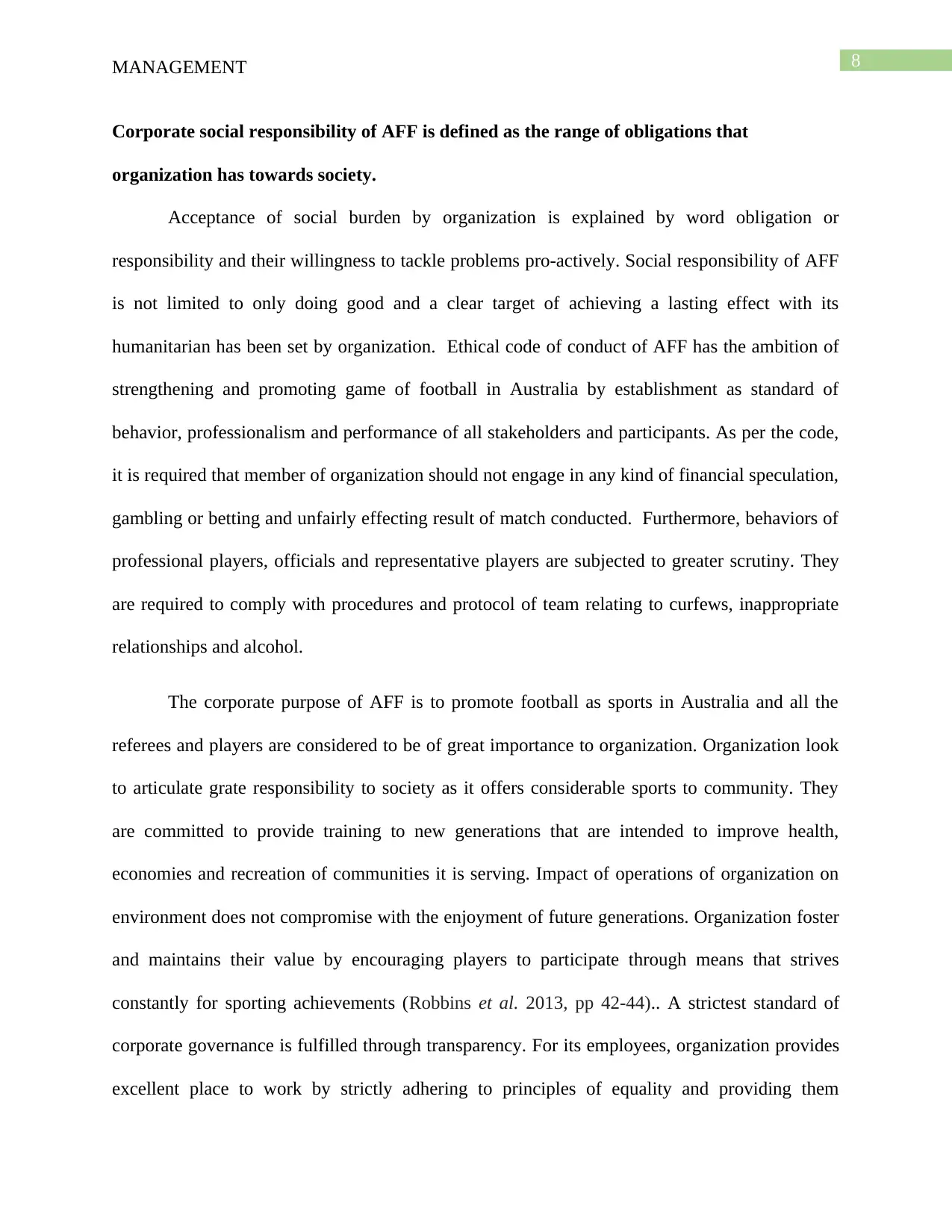
8MANAGEMENT
Corporate social responsibility of AFF is defined as the range of obligations that
organization has towards society.
Acceptance of social burden by organization is explained by word obligation or
responsibility and their willingness to tackle problems pro-actively. Social responsibility of AFF
is not limited to only doing good and a clear target of achieving a lasting effect with its
humanitarian has been set by organization. Ethical code of conduct of AFF has the ambition of
strengthening and promoting game of football in Australia by establishment as standard of
behavior, professionalism and performance of all stakeholders and participants. As per the code,
it is required that member of organization should not engage in any kind of financial speculation,
gambling or betting and unfairly effecting result of match conducted. Furthermore, behaviors of
professional players, officials and representative players are subjected to greater scrutiny. They
are required to comply with procedures and protocol of team relating to curfews, inappropriate
relationships and alcohol.
The corporate purpose of AFF is to promote football as sports in Australia and all the
referees and players are considered to be of great importance to organization. Organization look
to articulate grate responsibility to society as it offers considerable sports to community. They
are committed to provide training to new generations that are intended to improve health,
economies and recreation of communities it is serving. Impact of operations of organization on
environment does not compromise with the enjoyment of future generations. Organization foster
and maintains their value by encouraging players to participate through means that strives
constantly for sporting achievements (Robbins et al. 2013, pp 42-44).. A strictest standard of
corporate governance is fulfilled through transparency. For its employees, organization provides
excellent place to work by strictly adhering to principles of equality and providing them
Corporate social responsibility of AFF is defined as the range of obligations that
organization has towards society.
Acceptance of social burden by organization is explained by word obligation or
responsibility and their willingness to tackle problems pro-actively. Social responsibility of AFF
is not limited to only doing good and a clear target of achieving a lasting effect with its
humanitarian has been set by organization. Ethical code of conduct of AFF has the ambition of
strengthening and promoting game of football in Australia by establishment as standard of
behavior, professionalism and performance of all stakeholders and participants. As per the code,
it is required that member of organization should not engage in any kind of financial speculation,
gambling or betting and unfairly effecting result of match conducted. Furthermore, behaviors of
professional players, officials and representative players are subjected to greater scrutiny. They
are required to comply with procedures and protocol of team relating to curfews, inappropriate
relationships and alcohol.
The corporate purpose of AFF is to promote football as sports in Australia and all the
referees and players are considered to be of great importance to organization. Organization look
to articulate grate responsibility to society as it offers considerable sports to community. They
are committed to provide training to new generations that are intended to improve health,
economies and recreation of communities it is serving. Impact of operations of organization on
environment does not compromise with the enjoyment of future generations. Organization foster
and maintains their value by encouraging players to participate through means that strives
constantly for sporting achievements (Robbins et al. 2013, pp 42-44).. A strictest standard of
corporate governance is fulfilled through transparency. For its employees, organization provides
excellent place to work by strictly adhering to principles of equality and providing them
⊘ This is a preview!⊘
Do you want full access?
Subscribe today to unlock all pages.

Trusted by 1+ million students worldwide
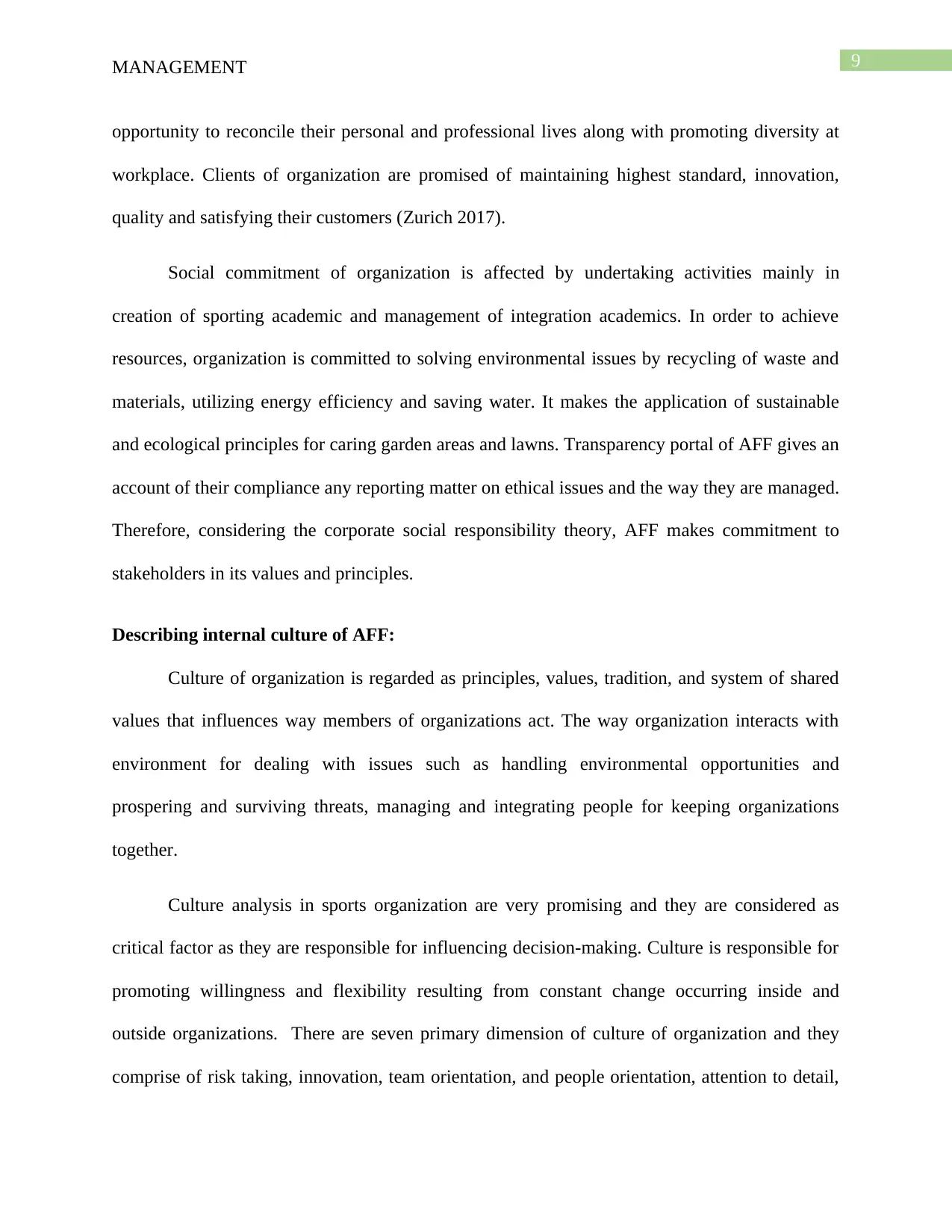
9MANAGEMENT
opportunity to reconcile their personal and professional lives along with promoting diversity at
workplace. Clients of organization are promised of maintaining highest standard, innovation,
quality and satisfying their customers (Zurich 2017).
Social commitment of organization is affected by undertaking activities mainly in
creation of sporting academic and management of integration academics. In order to achieve
resources, organization is committed to solving environmental issues by recycling of waste and
materials, utilizing energy efficiency and saving water. It makes the application of sustainable
and ecological principles for caring garden areas and lawns. Transparency portal of AFF gives an
account of their compliance any reporting matter on ethical issues and the way they are managed.
Therefore, considering the corporate social responsibility theory, AFF makes commitment to
stakeholders in its values and principles.
Describing internal culture of AFF:
Culture of organization is regarded as principles, values, tradition, and system of shared
values that influences way members of organizations act. The way organization interacts with
environment for dealing with issues such as handling environmental opportunities and
prospering and surviving threats, managing and integrating people for keeping organizations
together.
Culture analysis in sports organization are very promising and they are considered as
critical factor as they are responsible for influencing decision-making. Culture is responsible for
promoting willingness and flexibility resulting from constant change occurring inside and
outside organizations. There are seven primary dimension of culture of organization and they
comprise of risk taking, innovation, team orientation, and people orientation, attention to detail,
opportunity to reconcile their personal and professional lives along with promoting diversity at
workplace. Clients of organization are promised of maintaining highest standard, innovation,
quality and satisfying their customers (Zurich 2017).
Social commitment of organization is affected by undertaking activities mainly in
creation of sporting academic and management of integration academics. In order to achieve
resources, organization is committed to solving environmental issues by recycling of waste and
materials, utilizing energy efficiency and saving water. It makes the application of sustainable
and ecological principles for caring garden areas and lawns. Transparency portal of AFF gives an
account of their compliance any reporting matter on ethical issues and the way they are managed.
Therefore, considering the corporate social responsibility theory, AFF makes commitment to
stakeholders in its values and principles.
Describing internal culture of AFF:
Culture of organization is regarded as principles, values, tradition, and system of shared
values that influences way members of organizations act. The way organization interacts with
environment for dealing with issues such as handling environmental opportunities and
prospering and surviving threats, managing and integrating people for keeping organizations
together.
Culture analysis in sports organization are very promising and they are considered as
critical factor as they are responsible for influencing decision-making. Culture is responsible for
promoting willingness and flexibility resulting from constant change occurring inside and
outside organizations. There are seven primary dimension of culture of organization and they
comprise of risk taking, innovation, team orientation, and people orientation, attention to detail,
Paraphrase This Document
Need a fresh take? Get an instant paraphrase of this document with our AI Paraphraser
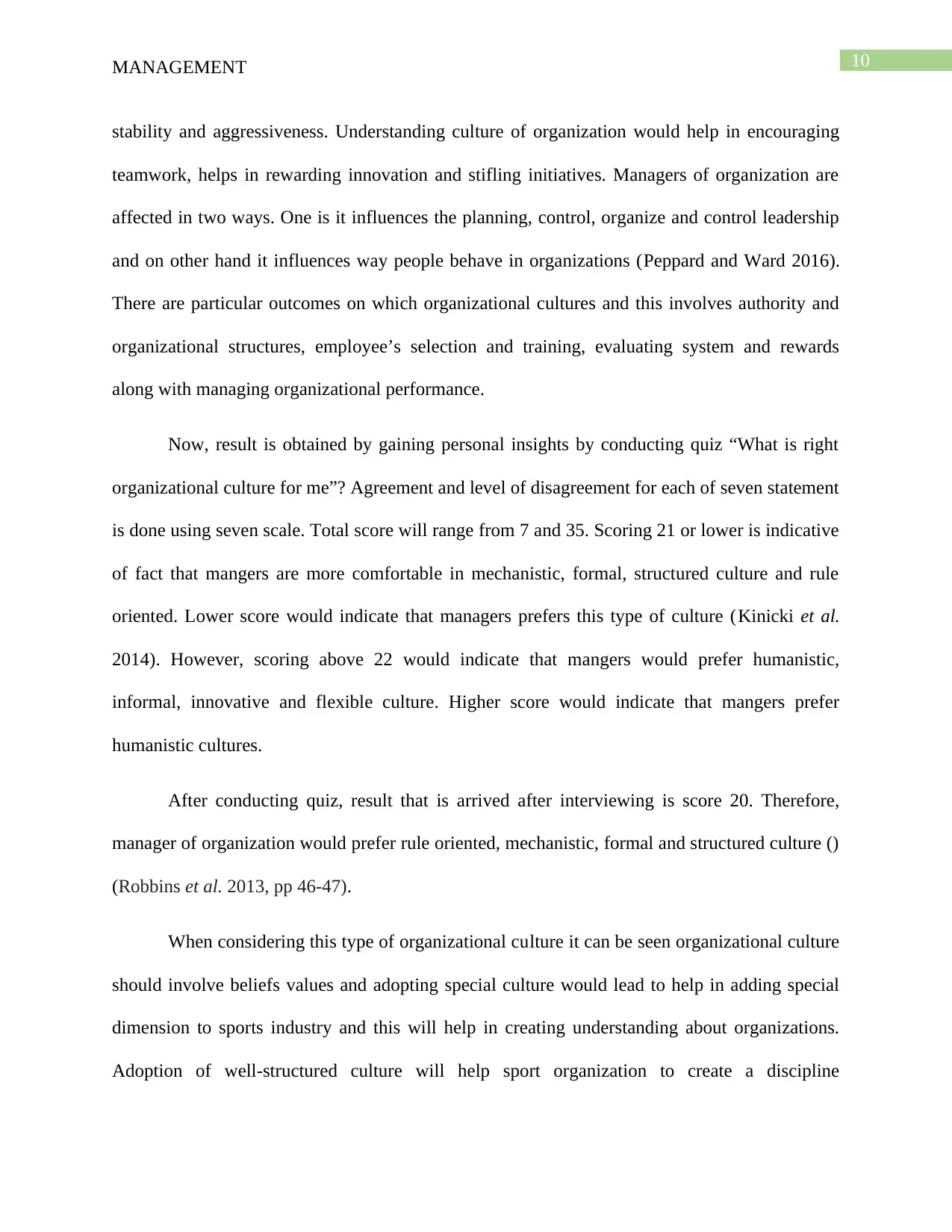
10MANAGEMENT
stability and aggressiveness. Understanding culture of organization would help in encouraging
teamwork, helps in rewarding innovation and stifling initiatives. Managers of organization are
affected in two ways. One is it influences the planning, control, organize and control leadership
and on other hand it influences way people behave in organizations (Peppard and Ward 2016).
There are particular outcomes on which organizational cultures and this involves authority and
organizational structures, employee’s selection and training, evaluating system and rewards
along with managing organizational performance.
Now, result is obtained by gaining personal insights by conducting quiz “What is right
organizational culture for me”? Agreement and level of disagreement for each of seven statement
is done using seven scale. Total score will range from 7 and 35. Scoring 21 or lower is indicative
of fact that mangers are more comfortable in mechanistic, formal, structured culture and rule
oriented. Lower score would indicate that managers prefers this type of culture (Kinicki et al.
2014). However, scoring above 22 would indicate that mangers would prefer humanistic,
informal, innovative and flexible culture. Higher score would indicate that mangers prefer
humanistic cultures.
After conducting quiz, result that is arrived after interviewing is score 20. Therefore,
manager of organization would prefer rule oriented, mechanistic, formal and structured culture ()
(Robbins et al. 2013, pp 46-47).
When considering this type of organizational culture it can be seen organizational culture
should involve beliefs values and adopting special culture would lead to help in adding special
dimension to sports industry and this will help in creating understanding about organizations.
Adoption of well-structured culture will help sport organization to create a discipline
stability and aggressiveness. Understanding culture of organization would help in encouraging
teamwork, helps in rewarding innovation and stifling initiatives. Managers of organization are
affected in two ways. One is it influences the planning, control, organize and control leadership
and on other hand it influences way people behave in organizations (Peppard and Ward 2016).
There are particular outcomes on which organizational cultures and this involves authority and
organizational structures, employee’s selection and training, evaluating system and rewards
along with managing organizational performance.
Now, result is obtained by gaining personal insights by conducting quiz “What is right
organizational culture for me”? Agreement and level of disagreement for each of seven statement
is done using seven scale. Total score will range from 7 and 35. Scoring 21 or lower is indicative
of fact that mangers are more comfortable in mechanistic, formal, structured culture and rule
oriented. Lower score would indicate that managers prefers this type of culture (Kinicki et al.
2014). However, scoring above 22 would indicate that mangers would prefer humanistic,
informal, innovative and flexible culture. Higher score would indicate that mangers prefer
humanistic cultures.
After conducting quiz, result that is arrived after interviewing is score 20. Therefore,
manager of organization would prefer rule oriented, mechanistic, formal and structured culture ()
(Robbins et al. 2013, pp 46-47).
When considering this type of organizational culture it can be seen organizational culture
should involve beliefs values and adopting special culture would lead to help in adding special
dimension to sports industry and this will help in creating understanding about organizations.
Adoption of well-structured culture will help sport organization to create a discipline
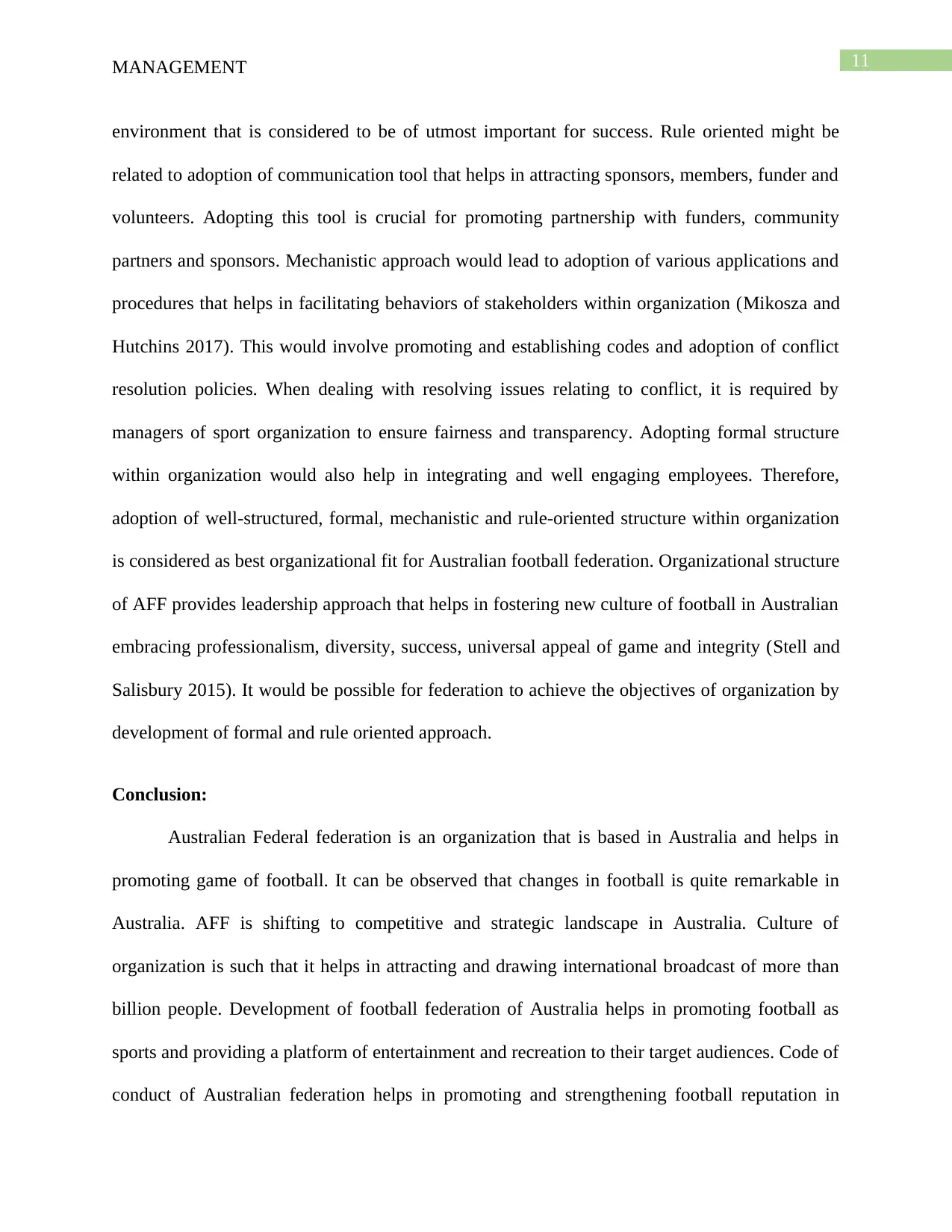
11MANAGEMENT
environment that is considered to be of utmost important for success. Rule oriented might be
related to adoption of communication tool that helps in attracting sponsors, members, funder and
volunteers. Adopting this tool is crucial for promoting partnership with funders, community
partners and sponsors. Mechanistic approach would lead to adoption of various applications and
procedures that helps in facilitating behaviors of stakeholders within organization (Mikosza and
Hutchins 2017). This would involve promoting and establishing codes and adoption of conflict
resolution policies. When dealing with resolving issues relating to conflict, it is required by
managers of sport organization to ensure fairness and transparency. Adopting formal structure
within organization would also help in integrating and well engaging employees. Therefore,
adoption of well-structured, formal, mechanistic and rule-oriented structure within organization
is considered as best organizational fit for Australian football federation. Organizational structure
of AFF provides leadership approach that helps in fostering new culture of football in Australian
embracing professionalism, diversity, success, universal appeal of game and integrity (Stell and
Salisbury 2015). It would be possible for federation to achieve the objectives of organization by
development of formal and rule oriented approach.
Conclusion:
Australian Federal federation is an organization that is based in Australia and helps in
promoting game of football. It can be observed that changes in football is quite remarkable in
Australia. AFF is shifting to competitive and strategic landscape in Australia. Culture of
organization is such that it helps in attracting and drawing international broadcast of more than
billion people. Development of football federation of Australia helps in promoting football as
sports and providing a platform of entertainment and recreation to their target audiences. Code of
conduct of Australian federation helps in promoting and strengthening football reputation in
environment that is considered to be of utmost important for success. Rule oriented might be
related to adoption of communication tool that helps in attracting sponsors, members, funder and
volunteers. Adopting this tool is crucial for promoting partnership with funders, community
partners and sponsors. Mechanistic approach would lead to adoption of various applications and
procedures that helps in facilitating behaviors of stakeholders within organization (Mikosza and
Hutchins 2017). This would involve promoting and establishing codes and adoption of conflict
resolution policies. When dealing with resolving issues relating to conflict, it is required by
managers of sport organization to ensure fairness and transparency. Adopting formal structure
within organization would also help in integrating and well engaging employees. Therefore,
adoption of well-structured, formal, mechanistic and rule-oriented structure within organization
is considered as best organizational fit for Australian football federation. Organizational structure
of AFF provides leadership approach that helps in fostering new culture of football in Australian
embracing professionalism, diversity, success, universal appeal of game and integrity (Stell and
Salisbury 2015). It would be possible for federation to achieve the objectives of organization by
development of formal and rule oriented approach.
Conclusion:
Australian Federal federation is an organization that is based in Australia and helps in
promoting game of football. It can be observed that changes in football is quite remarkable in
Australia. AFF is shifting to competitive and strategic landscape in Australia. Culture of
organization is such that it helps in attracting and drawing international broadcast of more than
billion people. Development of football federation of Australia helps in promoting football as
sports and providing a platform of entertainment and recreation to their target audiences. Code of
conduct of Australian federation helps in promoting and strengthening football reputation in
⊘ This is a preview!⊘
Do you want full access?
Subscribe today to unlock all pages.

Trusted by 1+ million students worldwide
1 out of 16
Related Documents
Your All-in-One AI-Powered Toolkit for Academic Success.
+13062052269
info@desklib.com
Available 24*7 on WhatsApp / Email
![[object Object]](/_next/static/media/star-bottom.7253800d.svg)
Unlock your academic potential
Copyright © 2020–2025 A2Z Services. All Rights Reserved. Developed and managed by ZUCOL.





